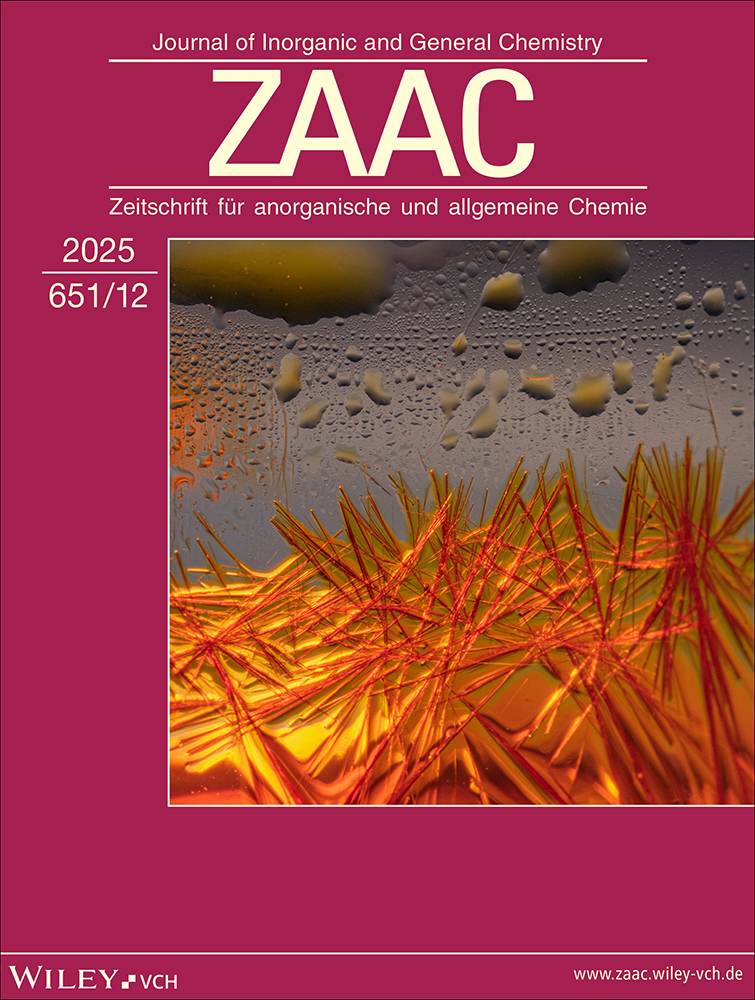Common Features in the Crystal Structures of the Compounds Bis(dimethylstibanyl)oxane and -sulfane, and the Minerals Valentinite and Stibnite (Grauspießglanz)
Abstract
enBis(dimethylstibanyl)oxane (1) and -sulfane (2), the two simplest organoelement species with an Sb–E–Sb fragment (E = O, S), were prepared by alkaline hydrolysis of bromodimethylstibane and by oxidation of tetramethyldistibane with sulfur [18], respectively. As shown by an x-ray structure analysis of compound 1 (m. p. < –20 °C; P212121, a = 675.9(2), b = 803.1(2), c = 1666.8(4) pm at –70 ± 2 °C; Z = 4; R1 = 0.042), the molecules (O–Sb 198.8 and 209.9 pm, Sb–O–Sb 123.0°) adopt a syn-anti conformation in the solid state and are arranged in zigzag chains along [010] via weak intermolecular O‥Sb interactions (258.5 pm, Sb–O‥Sb 117.8°, O‥Sb–O 173.5°) making use, however, of only one Me2Sb moiety. Primary and secondary bond lengths and angles agree very well with corresponding values published for valentinite, the orthorhombic modification of antimony(III) oxide [3]. Bis(dimethylstibanyl)sulfane (2) (m. p. 29 to 31 °C) crystallizes in the uncommon space group P6522 (a = 927.8(3), c = 1940.9(7) pm at –100 ± 2 °C; Z = 6; R1 = 0.021). Owing to coordination numbers of (1 + 1) and (2 + 2) for both Me2Sb groups and the sulfur atom, respectively, molecules with an approximate syn-syn conformation (S–Sb 249.8 pm, Sb–S–Sb 92.35°) build up a three-dimensional net of double helices which are linked together by Sb‥S contacts (316.4 pm). These parameters shed more light onto the rather complicated structure and bonding situation in stibnite (antimony(III) sulfide [4]). The molecular packing of compound 2 is compared with the structures of relevant inorganic solids, especially with that of β-quartz [37].
Abstract
deGemeinsamkeiten in den Kristallstrukturen der Verbindungen Bis(dimethylstibanyl)oxan und -sulfan und den Mineralien Valentinit und Stibnit (Grauspießglanz)
Bis(dimethylstibanyl)oxan (1) und -sulfan (2), die beiden einfachsten elementorganischen Vertreter mit einer Sb–E–Sb-Einheit (E = O, S) wurden durch alkalische Hydrolyse von Bromdimethylstiban bzw. durch Oxidation von Tetramethyldistiban mit Schwefel [18] dargestellt. Nach den Ergebnissen einer Röntgenstrukturanalyse an Verbindung 1 (Schmp. < –20 °C; P212121, a = 675,9(2), b = 803,1(2), c = 1666,8(4) pm bei –70 ± 2 °C; Z = 4; R1 = 0,042) nehmen die Moleküle (O–Sb 198,8 und 209,9 pm; Sb–O–Sb 123.0°) im Festkörper die syn-anti Konformation ein und ordnen sich unter Beteiligung nur einer der beiden Me2Sb-Gruppen über kurze intermolekulare O‥Sb Kontakte (258,5 pm; Sb–O‥Sb 117,8°; O‥Sb–O 173,5°) zu Zickzack-Ketten längs [010] an. Ähnliche Bindungslängen, -winkel und Kontakte treten in der bekannten Kristallstruktur des Minerals Valentinit, der orthorhombischen Modifikation des Antimon(III)-oxids [3], auf. Bis(dimethylstibanyl)sulfan (2) (Schmp. 29 bis 31 °C) kristallisiert in der verhältnismäßig seltenen Raumgruppe P6522 (a = 927,8(3), c = 1940,9(7) pm bei –100 ± 2 °C; Z = 6; R1 = 0,021). Mit Koordinationszahlen von (1 + 1) für nun alle Me2Sb-Gruppen bzw. (2 + 2) für die Schwefelatome bauen die annähernd syn-syn konformierten Moleküle (S–Sb 249,8 pm; Sb–S–Sb 92,35°) über Sb‥S Kontakte (316,4 pm) eine dreidimensional verknüpfte Anordnung von Doppelhelices auf. Mit den an Verbindung 2 bestimmten Werten lassen sich entsprechende Parameter aus der verhältnismäßig komplizierten und bindungstheoretisch schwer verständlichen Struktur des Minerals Stibnit (Grauspießglanz, Sb2S3 [4]) gut einordnen. Die Packung der Bis(dimethylstibanyl)sulfan-Moleküle wird mit einigen im Aufbau ähnlichen anorganischen Festkörpern, insbesondere aber mit β-Quarz [37] verglichen.




